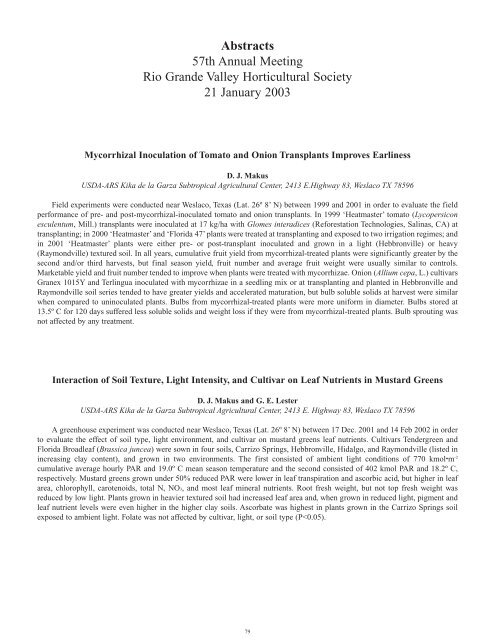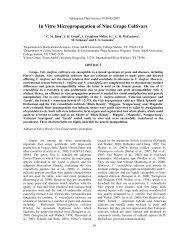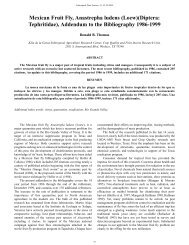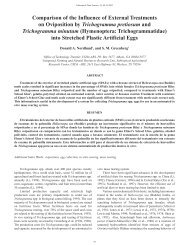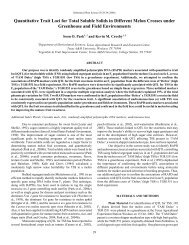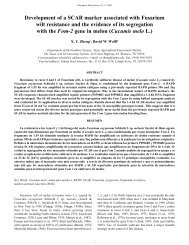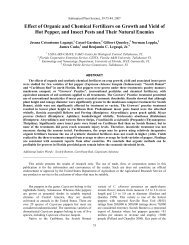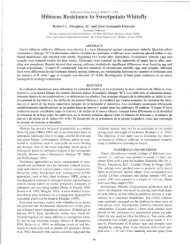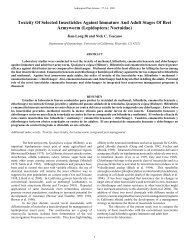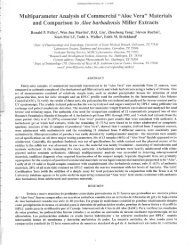Abstracts - Subtropical Plant Science Society
Abstracts - Subtropical Plant Science Society
Abstracts - Subtropical Plant Science Society
You also want an ePaper? Increase the reach of your titles
YUMPU automatically turns print PDFs into web optimized ePapers that Google loves.
<strong>Abstracts</strong><br />
57th Annual Meeting<br />
Rio Grande Valley Horticultural <strong>Society</strong><br />
21 January 2003<br />
Mycorrhizal Inoculation of Tomato and Onion Transplants Improves Earliness<br />
D. J. Makus<br />
USDA-ARS Kika de la Garza <strong>Subtropical</strong> Agricultural Center, 2413 E.Highway 83, Weslaco TX 78596<br />
Field experiments were conducted near Weslaco, Texas (Lat. 26º 8’ N) between 1999 and 2001 in order to evaluate the field<br />
performance of pre- and post-mycorrhizal-inoculated tomato and onion transplants. In 1999 ‘Heatmaster’ tomato (Lycopersicon<br />
esculentum, Mill.) transplants were inoculated at 17 kg/ha with Glomes interadices (Reforestation Technologies, Salinas, CA) at<br />
transplanting; in 2000 ‘Heatmaster’ and ‘Florida 47’ plants were treated at transplanting and exposed to two irrigation regimes; and<br />
in 2001 ‘Heatmaster’ plants were either pre- or post-transplant inoculated and grown in a light (Hebbronville) or heavy<br />
(Raymondville) textured soil. In all years, cumulative fruit yield from mycorrhizal-treated plants were significantly greater by the<br />
second and/or third harvests, but final season yield, fruit number and average fruit weight were usually similar to controls.<br />
Marketable yield and fruit number tended to improve when plants were treated with mycorrhizae. Onion (Allium cepa, L.) cultivars<br />
Granex 1015Y and Terlingua inoculated with mycorrhizae in a seedling mix or at transplanting and planted in Hebbronville and<br />
Raymondville soil series tended to have greater yields and accelerated maturation, but bulb soluble solids at harvest were similar<br />
when compared to uninoculated plants. Bulbs from mycorrhizal-treated plants were more uniform in diameter. Bulbs stored at<br />
13.5º C for 120 days suffered less soluble solids and weight loss if they were from mycorrhizal-treated plants. Bulb sprouting was<br />
not affected by any treatment.<br />
Interaction of Soil Texture, Light Intensity, and Cultivar on Leaf Nutrients in Mustard Greens<br />
D. J. Makus and G. E. Lester<br />
USDA-ARS Kika de la Garza <strong>Subtropical</strong> Agricultural Center, 2413 E. Highway 83, Weslaco TX 78596<br />
A greenhouse experiment was conducted near Weslaco, Texas (Lat. 26º 8’ N) between 17 Dec. 2001 and 14 Feb 2002 in order<br />
to evaluate the effect of soil type, light environment, and cultivar on mustard greens leaf nutrients. Cultivars Tendergreen and<br />
Florida Broadleaf (Brassica juncea) were sown in four soils, Carrizo Springs, Hebbronville, Hidalgo, and Raymondville (listed in<br />
increasing clay content), and grown in two environments. The first consisted of ambient light conditions of 770 kmol•m -2<br />
cumulative average hourly PAR and 19.0º C mean season temperature and the second consisted of 402 kmol PAR and 18.2º C,<br />
respectively. Mustard greens grown under 50% reduced PAR were lower in leaf transpiration and ascorbic acid, but higher in leaf<br />
area, chlorophyll, carotenoids, total N, NO3, and most leaf mineral nutrients. Root fresh weight, but not top fresh weight was<br />
reduced by low light. <strong>Plant</strong>s grown in heavier textured soil had increased leaf area and, when grown in reduced light, pigment and<br />
leaf nutrient levels were even higher in the higher clay soils. Ascorbate was highest in plants grown in the Carrizo Springs soil<br />
exposed to ambient light. Folate was not affected by cultivar, light, or soil type (P
Some New Information on Citrus psorosis virus in Texas.<br />
H. Miao, M. Seyran, J. V. da Graça, and M. Skaria<br />
Texas A & M University-Kingsville, Citrus Center, 306 N. International Blvd., Weslaco, TX 78596<br />
Four major tree-killing freezes (in 1951, 1962, 1983 and 1989) drastically reduced the commercial citrus acreage in the Lower<br />
Rio Grande Valley. Indirectly, these freezes reduced the incidence of citrus trees with symptoms of citrus psorosis disease. The<br />
development and commercial success of a new (psorosis-free) grapefruit cultivar, ‘Rio Red’ through mutation breeding of seedlings<br />
derived budwood also helped to reduce the overall incidence of psorosis in new orchards in Texas. However, in the past 6 years,<br />
we have observed field symptoms of psorosis in new plantations (post-1989), old plantations (trees pruned after the 1983 freeze),<br />
and dooryard trees (post-1983). In a recent survey involving 2,513 grapefruit trees of various varieties, obvious psorosis incidence<br />
was 3.5%, with another 4.9% showing psorosis-like symptoms. Biological indexing of several trees was done by grafting young<br />
shoots onto sweet orange (Pineapple, Dweet tangor, Madame Vinous) and Duncan grapefruit indicator plants. Typical symptoms<br />
were observed on indicator plants 4-6 weeks after grafting. The pattern of adjacent infected trees along flood irrigated rows in a<br />
commercial citrus orchard indicates a possible natural spread of this disease. A related virus in lettuce was recently showed to be<br />
spread by Olpidium. Preliminary studies conducted involving examination and sectioning of feeder roots from symptomatic citrus<br />
trees and culturing of soil with baits showed the presence of Olpidium-like fungus with resting spores. The Olpidium-like fungus<br />
in feeder roots of symptomatic trees strengthens the hypothesis of natural transmission of Citrus psorosis virus. However,<br />
verification of the virus-vector relationship needs to be established.<br />
Sclerenchyma Cell Deterioration of Citrus tristeza virus-infected Mexican Lime<br />
M. Skaria and H. Miao<br />
Texas A & M University-Kingsville, Citrus Center, 306 N.International Blvd., Weslaco, TX 78596<br />
Mexican lime leaf veins infected with a severe Citrus tristeza virus (CTV) strain (CTV-3) and a mild strain (T-TX 8) were<br />
compared. It is a universal indicator plant for diagnosing virtually all strains of CTV which can cause tree death, stem pitting, or<br />
mild reactions. Many translucent areas in the vein are prominent in the leaves infected with a severe strain and less prominent with<br />
mild strains of CTV. Cross sections of veins from the prominently translucent, slightly translucent, non-translucent, and ‘healthy’<br />
areas were compared for sclerenchyma cell degradation. These cells form a sheath around the leaf vascular bundles. They are thickwalled,<br />
lignified, and mineralized cells that provide mechanical support. Specimens for microscopy were prepared with free hand<br />
sections and stained with a Fungi-Fluor and examined under a Nikon Eclipse TE 300 fluorescence microscope with a<br />
CoolSNAP- Procf monochrome camera. In the severe strain infected plant, sclerenchyma cell degradation was 63% of the total<br />
cells in sections from the prominent vein clearing area and 34-48% in less prominent areas. In the mild strain infected plant, the<br />
highest cell degradation was only 40%. Sections from non-translucent and >healthy=areas had all cells intact. This appears to be<br />
the first quantitative report of sclerenchyma cell degradation associated with CTV infection.<br />
Effective New Lure Maximizes Anastrepha Fruit Fly Captures in North and South America<br />
David C. Robacker<br />
USDA-ARS Kika de la Garza <strong>Subtropical</strong> Agricultural Center, 2413 E.Highway 83, Weslaco TX 78596<br />
A synthetic lure developed jointly by IPM Tech (Portland, Oregon) and USDA-ARS (Weslaco, Texas) surpassed expectations<br />
for both attractiveness to Anastrepha and longevity in the field. IPM Tech lures outperformed Biolure (Suterra, Inc.) 2- component<br />
lures advertised effective for Mexican fruit flies (A. ludens) 5 fold when used on sticky yellow panel traps in grapefruit orchards<br />
in south Texas. In Peru, IPM Tech lures tested on sticky bottle traps outclassed standard (SENASA) ammonium phosphate McPhail<br />
traps 20 to 1 for captures of South American fruit flies (A. fraterculus) and over 100 to nothing for Mediterranean fruit flies<br />
(Ceratitis capitata). IPM Tech lures lasted upwards of 16 weeks in these tests. The IPM Tech Anastrepha lure shows great promise<br />
as a tool for detection and monitoring of the Mexican fruit fly, other species of Anastepha and the Mediterranean fruit fly.<br />
80
Monitoring Population Dynamics of Thrips tabaci (Thysanoptera: Thripidae)<br />
and predacious Natural Enemies on Onions in South Texas.<br />
Tong-Xian Liu and C. C. Chu<br />
Texas Agricultural Experiment Station, Texas A & M University, 2415 E. Highway 83, Weslaco TX 78596<br />
The population dynamics and stage composition of Thrips tabaci, and predacious natural enemies in lambda-cyhalothrin and<br />
methomyl treated and untreated onion plants were determined during the spring season using the whole-plant sampling method. In<br />
addition, sticky blue and white plastic cup traps and CC traps were used for trapping thrips. Result from this study indicated that<br />
the whole-plants sampling with absolute numbers of T. tabaci on onion plants was the most accurate method, but it was also most<br />
time consuming. Sampling thrips adults could provide a relatively good estimation of the total thrips population on onion plants<br />
with 70-75% precision. Of the developmental stages of T. tabaci on onion plants, 76-85% were nymphs,
A Novel, Rapid, Sensitive and Continuous Spectrophotometric Assay for the<br />
Determination of Diamondback Moth General Esterase Activity<br />
Xiaodun He<br />
Beneficial Insects Research Unit, KGSARC, ARS, USDA, 2413 E. Highway 83, Weslaco, TX 78596 (dhe@weslaco.ars.usda.gov)<br />
Conventional methods to determine general esterase activity from insects are composed of a three-step process where the<br />
esterase is allowed to hydrolyze a 1-naphthyl acetate substrate, that reaction is quenched by a SDS detergent, and then a Fast Blue<br />
B dye complex is formed with 1-naphthol, the product of 1-naphthyl acetate hydrolysis. These methods measure dye-product<br />
complex rather than the product. Measurement of the dye-product complex can lead to inaccuracies in the determination of 1-<br />
naphthol concentration. A new method continuously monitors the formation of 1-naphthol with the hydrolysis of a general esterase<br />
substrate at 320 nm. The esterase activity was determined by the slope changes of absorbance over minutes. The 1-naphthol product<br />
from the esterase reaction was confirmed by HPLC. The optimum pH value of esterase ranged from 6.0 to 7.5 in a sodium<br />
phosphate buffer, suggesting that esterase be a weakly pH-dependent enzyme. Divalent Mg 2+ enhanced esterase activity but<br />
monovalent K + and Na + inhibited it. The optimum temperature for esterase activity was from 33º to 42º C. Denaturation of the<br />
esterase protein occurred at 5º C or at 60º C. The Km and Vmax values of the esterase were 28±2 M and 6.0±0.1 M/min, respectively,<br />
at 37º C for 1-naphthyl acetate. The Ki value was 9±2 M using azadirachtin, an insecticide from neem tree, Azadirachta indica<br />
(A.Juss). Azadirachtin was a reversible competitive inhibitor of the esterase activity. The method provides a rapid and sensitive<br />
assay for general esterases extracted from a single diamondback moth in 1 to 10 minutes.<br />
Molecular Detection of Transgenic Food Products<br />
Alberto Mendoza, Antonia Cruz, Susana Fernández, Diana Reséndez, and Hugo A. Barrera Saldaña<br />
Center for Genomic Biotechnology, IPN, Reynosa, Tam., Mexico<br />
One third of the maize (corn) cultured in 1998 in North America was genetically modified and according to estimates, within<br />
10 years this proportion will increase to 75%. This has created a series of concerns within the agricultural food industry to know<br />
if their raw materials originate from Genetically Modified Organisms (GMO). One of the most effective and accepted<br />
technologies for the detection and characterization of introduced DNA sequences in transgenic plants has been the Polymerase<br />
Chain Reaction (PCR). Several DNA sequences can be detected and these can be classified into three categories: 1) sequences<br />
that regulate the expression of the gene (promotor 35S and terminator Tnos); 2) genetic markers, usually genes, that confer<br />
resistance to some antibiotics; 3) transgenes, widely used ones such as the Cry series genes from Bacillus thuringiensis. In our<br />
laboratory we have established the analysis of possible GMOs for diverse foods products, such as grains, flour, Atortillas@ and<br />
even processed food. The analyses include the detection of the zeine gene as a positive control of the reaction of the PCR in maize<br />
samples, the lectin gene of soya, and the Cauliflower mosaic virus 35S promoter, since it is one of the most widely promoters<br />
in the generation of GMOS. One of the key elements for success is genomic DNA extraction. The experience of different analyses<br />
of diverse maize products will be shown. So far, we are adapting the methods for Real-time PCR, which will be more accurate<br />
for mixture of samples.<br />
Molecular Differentiation of Mild and Severe Citrus tristeza virus Strains<br />
Alberto Mendoza, César G. Salazár, Omar Alvarado, Antonia Cruz and Hugo A. Barrera Saldaña<br />
Center for Genomic Biotechnology, IPN, Reynosa, Tam., Mexico<br />
Citrus tristeza virus (CTV) is the most important viral disease of citrus causing losses of more than 100 million trees<br />
worldwide. The virus is transmitted by Toxoptera citricida and infected grafts. Most visible symptoms caused by the CTV are<br />
decline and death of trees grafted on Citrus aurantium L. or Citrus macrophylla. Early detection of CTV has relied mainly on<br />
serology but increasingly on nucleic acids methods. Recent achievements include sequencing of the virus genome and transgenic<br />
citrus resistant to the virus. Our objective was to develop a nucleic acid method for differentiating CTV strains. In order to<br />
82
accomplish our objective we amplified the virus coat protein gene (p25), and then we screened isolates for restriction enzyme<br />
polymorphisms. We found that Hae III distinguishes the mild from severe races. Furthermore, Kpn I seems to differentiate those<br />
strains causing stem pitting from those inducing decline. The multiple alignment of the analyzed amino acids sequences results in<br />
a dendogram separating the mild strains from severe ones. The sequence analysis of the gene p25 showed two possible amino acids,<br />
glycine and threonine in positions 49 and 63, respectively, that are conserved in the severe strains and thus may be involved in the<br />
pathogenicity of the CTV. The polymorphism of the 5 UTR was also analyzed using specific primers for mild and severe CTV<br />
races. Currently, we are in the process of collecting and analyzing higher number of p25 gene sequences and gathering data on its<br />
biological behavior, to further validate our results.<br />
Masking the Effect of Inoculation of Tropical Azospirillum brasilense<br />
by Indigenous Azospirilla from a Semi-arid Zone<br />
Alberto Mendoza, Jesús G. García, Blanca L. Lugo, Antonia Cruz, Emilio Olivares and Hugo A. Barrera-Saldaña<br />
Center for Genomic Biotechnology, IPN, Reynosa, Tam., Mexico<br />
Two maize (corn) field experiments with inoculant were carried out in the semi-arid region of Northeast Mexico, during the<br />
winter-spring and fall-autumn of 2001 growing seasons. The inoculant consisted of a mixture of Azospirillum brasilense strains<br />
isolated from maize roots in the tropical region of Mexico. The antibiotic resistance of the strain confirmed the establishment of<br />
the inoculated strains. The Azospirilla concentration was lower than that reported in rich soils, predominantly acidic, from<br />
temperate zones. But in all treatments, numbers of Azospirillum were similar with a maximum number of bacteria per gram of<br />
tissue of only 1 X 10 3 . All treatments gave a grain yield between 5 to 5.4 ton/ha, but did not significantly increase grain yield over<br />
that of the non- inoculated control plot. Failure to increased yield with Azospirillum could be due to contrasted environmental<br />
conditions in the region in compare to the bacteria's region of origin. Significant inoculation effects on grain yields were observed<br />
for the second experiment (Fall-Winter), in which a 27% of yield increase from 3.7 to 4.11 ton/ha was observed. The results of<br />
the present study over the two field experiments strongly indicate that a more detailed, study of plant genotype-Azospirillum spp<br />
and indigenous strain interaction are required. In addition, a better interaction with the plant is needed to allow better inoculation<br />
results of cereal crops in the arid or semi-arid region where environmental conditions strongly differ from the natural habitat of<br />
A. brasilense.<br />
Seasonal Fluctuation of Aphid Predators Associated with Citrus in Northeast Mexico<br />
J. Isabel López-Arroyo<br />
INIFAP, General Terán, NL, Mexico<br />
The citrus industry of northeast Mexico is at the risk of invasion by the brown citrus aphid, Toxoptera citricida (Kirkaldy)<br />
(Homoptera: Aphididae), the most efficient vector of Citrus tristeza virus, a pathogen that has caused the death of millions of citrus<br />
trees worldwide. In order to contribute in the establishment of a program for the biological control of T. citricida in northeast<br />
Mexico, the present study was carried out to determine the presence and abundance of aphid predators in the citrus of the region.<br />
After two years of samplings in citrus trees, the collected aphid predators were the green lacewings Ceraeochrysa sp. nr. cincta<br />
(Schneider), Ceraeochrys valida (Banks), Chrysopa nigricornis Burmeister, Chrysopa quadripunctata Burmeister, Chrysoperla<br />
comanche (Banks), Chrysoperla externa (Hagen), Chrysoperla rufilabris (Burmeister), Eremochrysa sp., and Leucochrysa<br />
mexicana (Banks) (Neuroptera: Chrysopidae), a species of brown lacewings (Neuroptera: Hemerobiidae), and the lady beetles<br />
Cycloneda sanguinea (L.), Hippodamia convergens Guer., and Olla v-nigrum (Mulsant) (Coleoptera: Coccinellidae). The<br />
chrysopids were significantly more abundant than the other predators. They were present mostly during the cool season of the year<br />
(from September to March) in the region. C. rufilabris was notably abundant during such period; however, the species was absent<br />
during the remaining of the year. In contrast, C. valida was collected under more variable climatic conditions. Unlike chrysopids,<br />
presence of coccinellids was not associated with weather conditions. The study has implications for conservation of the different<br />
aphid predators and for taking advantage of their presence in the citrus orchards.<br />
83
Flash Chromatographic Separation and Isolation of Structurally Similar Flavanoid Glucosides<br />
Girija Raman and Bhimanagouda S. Patil<br />
Texas A & M University-Kingsville, Citrus Center, 306 N.International Blvd., Weslaco, TX 78596<br />
Flavanoid glucosides have been shown to prevent certain chronic diseases such as cancer, diseases of peripheral circulation<br />
and to lower blood pressure. Citrus molasses, a waste residue, has a large concentration of limonoid glucosides and flavanoid<br />
glucosides. Isolation of the pure glucosides from the mixture proves to be a complex problem due to their structural similarity. A<br />
rapid separation technique using a combination of adsorption chromatography and flash chromatography was designed to isolate<br />
these compounds from the mixture. The citrus molasses was de-pectinised and passed through ion-exchange resins to obtain an<br />
extract rich in glucosides. The enriched extract was agitated under cold conditions to separate the glucosides, which are present in<br />
maximum concentration. The freeze-dried extract was further separated using flash chromatographic technique. A small four-step<br />
gradient method using acetonitrile and water as mobile phase was developed. Structurally very similar flavanoid glucosides can be<br />
separated to the extent of 94%. This system can be used as a rapid technique for separation of closely related flavanoid glucosides.<br />
Development of a Trichoderma Based Biofungicide Suitable for<br />
Northern Tamaulipas Weather Conditions<br />
C. Patricia Larralde-Corona, Ma. Rufina Santiano-Mena, Cuauhtémoc Jacques, Diana Reséndez<br />
Center for Genomic Biotechnology, IPN, Reynosa, Tam., Mexico<br />
The northeast region of México comprises the states of Tamaulipas, Nuevo Leon and Coahuila, having common border with<br />
the south of Texas. Typical weather along this region varies from dry to hot sub-tropical, and specifically in the state of Tamaulipas<br />
we found mild alkaline and saline soils. Crops cultivated in this part of the country are mainly sorghum, cotton, maize, bean and<br />
okra. Disease-causing fungi commonly found are Aspergillus, Fusarium, Claviceps and Macrophomina. Some of these fungi can<br />
be predated by several species of the genera Trichoderma. Although several Trichoderma biocontrol products are reported, and<br />
some are even available in the market, the microorganisms used on them were isolated from regions of milder weather. We hence<br />
have focused on the isolation, characterization and formulation a biocontrol agent product suitable for the crops (mainly sorghum)<br />
of the north of Tamaulipas. We are using the fungus Macrophomina phaseolina as a disease causing agent model (Charcoal Stalk<br />
Rot), isolated from sorghum and maize at Río Bravo cropping zone, as well as isolates from other parts of México and Italy. During<br />
the first stage of this project, we isolated 9 Trichoderma strains, which had been characterized morphologically and by means of<br />
AFLP’s (amplified fragment length polymorphisms). We had also performed confrontation experiments for in vitro determination<br />
of the efficacy of biocontrol of the isolates at increasing temperatures, measuring the degree of growth inhibition as well as<br />
assessing the degree on invasion by means of an image analyzer. These results have allowed us to choose the most effective<br />
Trichoderma isolates to be used in the next stage in planta in the greenhouse.<br />
Agave durangensis Adaptation on Four Substrates<br />
Cuauhtemoc Jacques Hernández, Jesús García Olivares, J. Luis Hernández Mendoza,<br />
Angel Salazar Bravo, Felipe Serrano Medina, and Hugo Barrera Saldaña<br />
Center for Genomic Biotechnology, IPN, Reynosa, Tam., Mexico<br />
The micro-culture of plant tissues is an alternative technique for Agave plant production. The advantage of plants produced by<br />
this system is the feasibility to program the plant production, obtaining healthy plants, industrial scope and selected plants for<br />
physiological genetic or commercial properties. In our laboratory we are making Agave durangensis cultures in a synthetic<br />
medium. After this, plants are transferred to plastic trays (with 98 holes) using 4 different substrates. The plant survival rates<br />
observed were 67, 92, 77 and 70% corresponding to clay, peat moss, clay-peat mixed (50-50%) and natural soil respectively. With<br />
respect to plant size, only 40% of plants less than 1 cm in height survive, compared plants 1 cm or more in height, which have a<br />
survival rate of about 98%.<br />
84
Use of a Hydroponic System for Lettuce Production in Reynosa, Tamaulipas<br />
Cuauhtemoc Jacques Hernández, J. Luis Hernández Mendoza, Jesús García Olivares,<br />
Felipe Serrano Medina, Angel Salazar Bravo and Hugo Barrera Saldaña<br />
Center for Genomic Biotechnology, IPN, Reynosa, Tam., Mexico<br />
The hydroponic system (NFT: nutrient film technique) was evaluated for the production of French lettuce (Lactuca sativa L.<br />
var. acephala) and Roman lettuce (Lactuca sativa L. var. longifolia) under greenhouse conditions in the cycle autumn-winter at<br />
Reynosa, Tamps. The seed plot was developed in autumn and the production in winter. The French lettuce production was 0.55<br />
kg/plant (23.6 ton/ha/cycle) and 0.40 kg/plant (23.6 ton/ha/cycle) when the frame of plantation was 4.3 and 5.9 plant/m 2 ,<br />
respectively. The Roman lettuce production was 0.55 kg/plant (32.4 ton/ha/cycle) with a frame of plantation was 5.9 plant/m 2 . The<br />
water consumption was 13.8 L/plant, corresponding 93.0% of this consumption to the evapo-transpiration and the rest to vegetative<br />
material. The cycle time was 27 days in the seed plot, 59 days in the hydroponic system until the harvest was finished.<br />
Agave potatorum Micropropagation<br />
Cuauhtemoc Jacques Hernández, Angel Salazar Bravo, Maribel Mireles, Jesús García Olivares,<br />
Felipe Serrano Medina, J. Luis Hernández Mendoza and Hugo Barrera Saldaña<br />
Center for Genomic Biotechnology, IPN, Reynosa, Tam., Mexico<br />
Tamaulipas has a high demand for agave plants for its fast growing tequila and mezcal industry. At present, the supply comes<br />
mainly from rootstocks, but micro-propagated plants are gaining more relevance each day. Our Center has been micro-propagating<br />
Agave durangensis for the last two years. Based on this experience, we are starting to micro-propagate A. potatorum cultured plants<br />
in Murachige and Skoog medium modified in our center. Our source of plant tissue is stem and meristematic areas of wild plants<br />
previously quarantined in our laboratories. Incubation is at 25º C under 1000 lux of brightness.The results show that 68% of<br />
vegetative tissues are generating healthy plants. On the other hand, 16% of plant tissues are dying and 16% contaminated. We now<br />
have fully developed plants ready to be transferred and evaluated in the field. Hopefully, they will become the source of high<br />
quality material to supply the tequila and mezcal industry of our state.<br />
85


